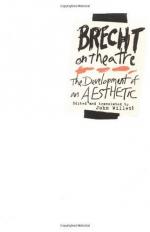
|
| Name: _________________________ | Period: ___________________ |
This test consists of 5 multiple choice questions, 5 short answer questions, and 10 short essay questions.
Multiple Choice Questions
1. Subordinating one's own _____to what one imagines those intentions to be is one of Brechts 'common tendencies for actors to guard against'.
(a) Soul.
(b) Reflection.
(c) Gifts and talents.
(d) Experience and observation.
2. The attitude of chasing away a fly is _____.
(a) Futile.
(b) Social gest.
(c) No social gest.
(d) Barbaric.
3. Brecht states that it is not the job of the Marxist-Leninist party to organize production of poetry as on a _____.
(a) Factory floor.
(b) Ford assembly line.
(c) Tomato farm.
(d) Poultry farm.
4. In terms of aesthetics, Galileo spoke of the elegance of certain _____.
(a) Subjects.
(b) Formulae.
(c) External techniques.
(d) Fundamentalist tendencies.
5. In Life of Galileo, Richard Gloster courts _____.
(a) His sister's best friend.
(b) His teacher.
(c) His cousin.
(d) His victim's widow.
Short Answer Questions
1. Who wrote the music for Mother Courage?
2. The pomp of _____ has a hollow gest.
3. Life of Galileo starts with a man having his _____.
4. A mass of _____ to develop the character are carried out when it is introduced among other characters of the play.
5. Brecht states that the titles of In Life of Galileo must include the _____.
Short Essay Questions
1. Why does Brecht say that mere catastrophe is a bad teacher?
2. What is Brecht's view on previews?
3. What role does observation play in acting?
4. How is a theatre's cultural standard decided and what is the fear that arises?
5. What is Brecht's definition of theatre?
6. How does Brecht describe his cities after the great war in "From the Mother Courage Model"?
7. What does Brecht say is considered to be social gest?
8. Why does Brecht complain about the use of Volkstumlich in the German language?
9. In what works did Brecht give up iambics and why?
10. Why did the actors sit openly on the stage in Neher's production of Antigone?
|
This section contains 621 words (approx. 3 pages at 300 words per page) |

|




